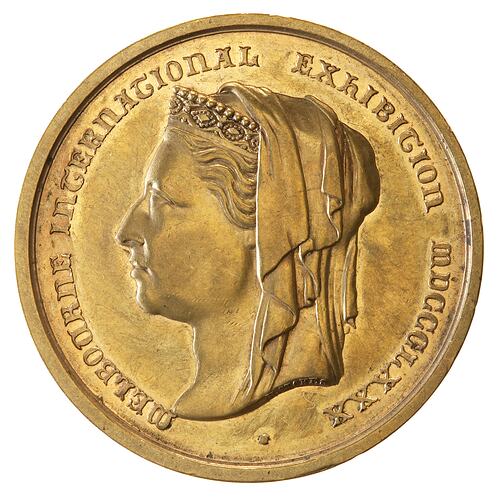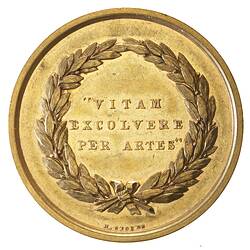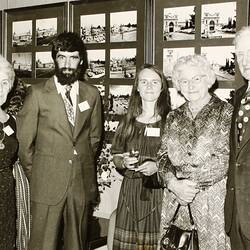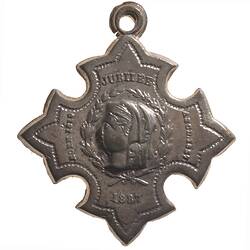Summary
Australia Victoria Melbourne
Medal - Melbourne International Exhibition Gold 1880 (AD)
Mint: Melbourne
Awarded to: Vale, W. M. K. Treasurer of the Exhibition for services
Other Details: This gold medal was awarded in 1880 at the Melbourne International Exhibition to the Hon. William M.K. Vale, M.P, J.P., Treasurer of the Exhibition Commission and chairman of its manufacturers' committee (Official Record, p.xvii and xxi). Vale was a barrister at the Victorian Supreme Court and a politician recently elected to the seat of Fitzroy. The following year he became Attorney-general and Minister for Justice. Vale was also a bookseller and an advocate of protection as the basis for social progress. He supported public education and technical training for workers. The Melbourne International Exhibition ran from 1 October 1880 to 30 April 1881. The exhibition building that still stands was constructed for the occasion, designed by Joseph Reed and built by David Mitchell. Over 1.3 million people visited the exhibition at a time when Melbourne's population was only around 282,000.
Physical Description
Gold medal awarded to Hon. W.M.K. Vale for services as Treasurer to the Exhibition Commission. It features a head of Queen Victoria facing left wearing coronet and veil by Harry Stokes (name on truncation), with the legend MELBOURNE INTERNATIONAL EXHIBITION MDCCCLXXX : The reverse has the legend "VITAM / EXCOLVERE / PER ARTES" WITHIN A CLOSED OLIVE WREATH and the artist's name H. STOKES in small letters at the bottom.
Obverse Description
Veiled head of Queen Victoria left; around, MELBOURNE INTERNATIONAL EXHIBITION MDCCCLXXX .
Reverse Description
Within wreath, "VITAM / EXCOLVERE / PER ARTES" below wreath in small letters, H.STOKES.
Edge Description
HON. WILLIAM MOUNTFORD KINSEY VALE, M.P. FOR SERVICES.
Significance
A competition for the design of a prize-winners medal for the 1880 Melbourne International Exhibition was arranged by the Exhibition Commission. A Committee was formed and a sketch produced to guide entrants to the competition. The competition was to be judged by V. Delves Broughton, Deputy Master of the Melbourne Mint, who would later oversee the actual production.
Broughton was not involved in the Committee's discussion about the preferred design, and was horrified when he saw the guide sketch that had been sent out to interested artists. The design was too complex (and, according to Broughton's correspondence, the relief too deep) to be produced. It appears he hastily wrote to each artist indicating that variations on the design were welcomed, and that the choce of winner would be based on which could be made from the thinnest guage of metal. He advised that the head of the Queen was unsuited to the task, and suggested that the Queen's head on the obverse of the Ashantee war medal by L.C. Wyon, featured in the Exhibition Catalogue, was a good model. Entrants were also directed to look at ancient medals and coins exhibited by the Mint.
The competition was won by Melbourne medallist and jeweller Ernst Altmann. The Melbourne Mint still rejected the design as too difficult to strike. Eventually a modified form of the Ashantee medal from the Sydney Mint presentation medal was used, combined with a simple reverse with wreath design entered by medallist Harry Stokes.
The medals were minted, and awarded in the folliwng manner. Gold, first prize with medal, for applications of new and useful principles, the production of useful machines, or great skill in manufacture, invention or design. Gold, second prize with certificate, for objects of art. Gold, third prize with certificate, for manufactures, products and industries of high merit. Silver and bronze medals were awarded for exhibits of lesser importance; silver and bronze level certificates were issued to lesser winners in each of these categories.
More Information
-
Collection Names
-
Collecting Areas
-
Acquisition Information
Transfer from National Gallery of Victoria (NGV), Honourable William M. Vale JP, 15 Mar 1976
-
Date Issued
1880 AD
-
Issued By
-
Awarded To
Honourable William M. Vale JP, Melbourne, Greater Melbourne, Victoria, Australia, 1880
Treasurer to the 1880 Exhibition Commission -
Person Depicted
-
Inscriptions
HON. WILLIAM MOUNTFORD KINSEY VALE, M.P. FOR SERVICES (edge) MELBOURNE INTERNATIONAL EXHIBITION MDCCCLXXX . around veiled head of Queen Victoria, (obverse) "VITAM / EXCOLVERE / PER ARTES" within wreath, below wreath in small letters, H.STOKES (reverse).
-
Series
-
Material
Gold
-
Axis
12
-
Classification
-
Category
-
Discipline
-
Type of item
-
Dimensions
39 mm (Outside Diameter), 51.01 g (Weight)
-
Shape
Round
-
References
Sharples, John P. 1990. Medals as Art: Australia and the Meszaros tradition, p.16.
[Book] 1882. Official Record of the Melbourne International Exhibition 1880-1881.
-
Keywords





